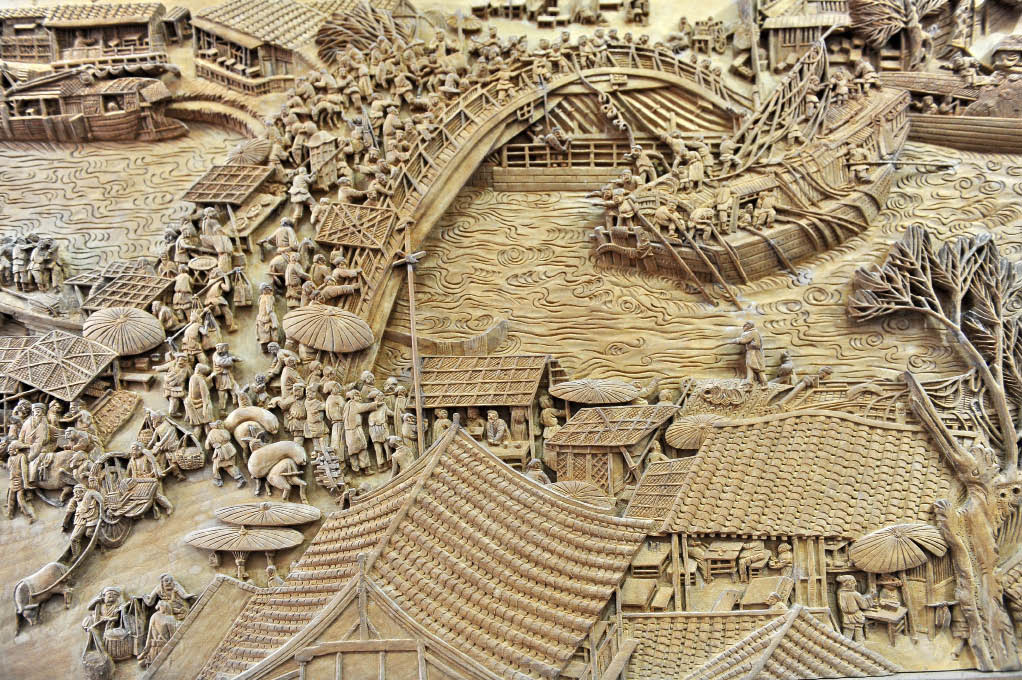Huizhou Woodcarver and Inheritor Wang Jinsheng
Wang then turned his attention to what he perceived as the unsightly packaging of these delicate artifacts, using his expertise to give the wooden boxes in which inkstones were presented greater aesthetic appeal. His endeavors and high skills won his colleagues’ admiration, and the epithet “Master Jin” (golden master).
 |
|
One segment of Wang’s replica of Qingming Festival at the Riverside, a classic 12th-century painting. Photos by Yu Xiangjun |
Large Relief Woodcarving of 500 Arhats on Mt. Lingshan
In 1982, then 55-year-old Wang Jinsheng reached retirement age. But due to his irreplaceable expertise, he was asked to carry on working for a few more years. Even after finally retiring in 1987, Wang carried on doing woodcarvings at home. His son encouraged him to go out more and enjoy his retirement with other elders, but Wang insisted that carving was his preferred recreational activity.
Wang’s innovations to traditional woodcarving added to them greater artistic value and hence collectibility. Many collectors came to him offering high prices for his works, but Wang stuck to his rule of taking all the time he needs to finish a piece of work. In other words, no matter what price was offered, he declined to abide by a deadline. As he explained, “Woodcarving is an art similar to painting. You need to take the time necessary to put your heart and soul into it by working through any artistic inclinations that might arise. Unless I can do my work to the best of my ability I would rather not do it at all.”
In 2001, the Buddhist Art Museum at the Lingshan Grand Buddha Scenic Area in Wuxi City, Jiangsu Province took the decision to commission a relief woodcarving of the 500 Arhats (Foe Destroyers). Twelve pieces of 2,000-year-old silkwood were selected for the carving. The expense and high significance of this work made choosing a carver a crucial task. Feng Qiyong, then in charge of this project, appointed a team to find the right person. Finally, on the recommendation of the Huangshan Painting and Calligraphy Academy, the task was assigned to Wang Jinsheng.
“When Feng Qiyong came to me I was dismayed to learn I would be working on a total 12 pieces of precious antique wood. As I had never carved on such a large scale before I was afraid I might ruin these raw materials, so told Feng I would first try working on one piece,” Wang said. When Wang showed his finished carving to Feng Qiyong he “thought highly of it, saying that he could see in it the essence of Huizhou woodcarving, and so regarded it as authentic Huizhou art.” The remaining 11 pieces of wood were then taken to Wang Jinsheng’s home. One thing worth mentioning is that silkwood has an extremely hard texture that calls for great strength in the artist’s wrists as well as fingers. High expertise, persistence and experience thus also define the quality of these carvings.
The 1.7-meter-high, 42-meter-long relief woodcarving, 500 Arhats Hall on Longevity Hill, effectively replicated a painting by Wang Fangyue in 1757 depicting Emperor Qianlong (1711-1799) supervising the building of the hall on Longevity Hill in the Yuanmingyuan, or Old Summer Palace. Unfortunately the painting was destroyed when the Anglo-French allied armies burned the palace down in 1860. Wang’s woodcarvings act as a memorial to it.
Self-endowed Legacies
The year 2007 marked the end of the three years Wang Jinsheng took to finish two woodcarvings (9 m x 0.5 m) replicating the Northern Song Dynasty painting Qingming Festival at the Riverside. Each carving includes more than 500 figures. A collector purchased one; the other remains in Wang’s studio, along with woodcarvings celebrating the painting One Hundred Horses by Lang Shining (Giuseppe Castiglione), court painter to the Qing Emperors for half a century, and certain other of his works. Relieved at successfully finishing Qingming Festival at the Riverside and having worked all his life for other people, Wang elected to keep these and other lovingly crafted works for himself.
Wang Jinsheng has waited two generations for a suitable heir to his wood carving expertise. His son did not inherit his skills, and it did not seem appropriate to teach woodcarving and the hard manual work it entails to his granddaughter. But Wang’s great-grandson, now 24, has been learning the craft from him for six years. Wang’s apprentices also reap the benefits of his skills and experience, along with students at the local vocational school where he gives classes. Wang has confidence in all his inheritors. He brought our meeting to an end with the remark, “Huizhou woodcarving has been passed down from our ancestors. I hope more people will get to know and love it, and that more master woodcarvers will appear.”
Profile:
Wang Jinsheng, inheritor of Huizhou wood, brick and stone carving, was born in 1928 in Shexian County in southern Anhui Province. He started learning woodcarving skills at the age of 16 from Wang Xulun, a Huizhou woodcarving master. Wang worked on the woodcarvings in Anhui Hall, a part of the Great Hall of the People in Beijing, and also contributed to the revival of Shezhou inkstones. His works have been widely collected by art lovers throughout the world, and presented to foreign dignitaries as national gifts. Among many others, Feng Qiyong, acclaimed expert on the classic novel A Dream of Red Mansions, has commended Wang Jinsheng as authentic inheritor of Huizhou woodcarving.

